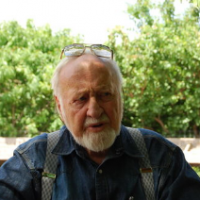A revolution disguised as organic gardening: in memory of Bill Mollison
Yesterday I had the following short tribute to Bill Mollison, co-originator of the permaculture concept, published in The Conversation.
It is with great sadness that I acknowledge the passing of Bill Mollison on Saturday, September 24 (1928-2016). He was one of the true pioneers of the modern environmental movement, not just in Australia but globally.
Best known as co-originator of the “permaculture” concept with David Holmgren, and recipient of the Right Livelihood Award in 1981, Mollison helped develop a holistic body of environmental theory and practice which is widely recognised as one of Australia’s finest and most original contributions to the global sustainability challenge.
A brief history of permaculture
Mollison grew up in Stanley, Tasmania. After leaving school at 15 he moved through a range of occupations before joining the CSIRO in the Wildlife Survey Section in 1954, where he developed his research experience and understanding of ecological systems.
He was later appointed to the University of Tasmania, which is where, in 1974, he met the brilliant and radical young research student, David Holmgren
The collaboration between Mollison and Holmgren resulted in the permaculture concept, culminating in the publication of their seminal work, Permaculture One in 1978, which sparked the global movement.
What is permaculture?
Permaculture defies simple definition and understanding. The term began as a fusion of “permanent” and “agriculture”. Even back in the 1970s, Mollison and Holmgren could see how destructive industrial agriculture was to natural habitats and topsoils, and how dependent it was on finite fossil fuels.
It was clear that these systems were unsustainable, a position ratified by scientific reports today which expose the alarming effects industrial agriculture has on biodiversity and climate stability. The two pioneering ecologists began to wonder what a “permanent agriculture” would look like. Thus permaculture was born.
In the broadest terms, permaculture is a design system that seeks to work with the laws of nature rather than against them. It aims to efficiently meet human needs without degrading the ecosystems we all rely on to flourish.
Put otherwise, permaculture is an attempt to design human systems and practices in ways that mimic the cycles of nature to eliminate waste, increase resilience and allow for the just and harmonious co-existence of human beings with other species.
A wide range of design principles were developed to help put these broad ideas and values into practice. This practical application and experimentation is what really defines permaculture. Before all else, participants in the movement get their hands in the soil and seek to walk the talk.
There is now a vast array of excellent books detailing the practice of permaculture, as well as outstanding websites such as the Permaculture Research Institute for those wanting to learn, share, explore and connect.
Although permaculture was initially focused on sustainable methods of organic food production, the concept soon evolved to embrace the broader design challenges of sustainable living – not just “permanent agriculture”, but “permanent culture”.
Today we face profound environmental and social challenges: ecological overshoot, climate instability, looming resource scarcity, and inequitable concentrations of wealth. In such a world the permaculture ethics of “care of people, care of planet, and fair share” imply radical changes to the way we live with each other and on the planet.
As well as transitioning away from fossil-fuel-dependent agriculture toward local organic production, permaculture implies the embrace of renewable energy systems, “simple living” lifestyles of modest consumption, as well as retrofitting the suburbs for sustainability and energy efficiency.
From a grassroots or community perspective, the transition towns and ecovillage movements acknowledge their profound debts to permaculture.
From a macroeconomic perspective, permaculture implies a degrowth transition to a steady-state economy that operates within the sustainable limits of the planet. Permaculture even has implications for what alternative forms of global development might look like.
So, in answer to the complex question “what is permaculture?”, perhaps the most concise response is to say with others that “permaculture is a revolution disguised as organic gardening”.
Bill Mollison’s legacy: a challenge to us all
Despite developing into a thriving global movement, permaculture still has not received the full attention it deserves. As the world continues to degrade ecosystems through the poor design of social and economic systems, it has never been clearer that permaculture is a way of life whose time has come.
Nevertheless, permaculture is not a panacea that can answer all challenges. Permaculture is not without its critics (see, for example, here and here). But I would argue that the lens of permaculture can certainly illuminate the path to a more sustainable and flourishing way of life, such that we ignore its insights at our own peril.
Thank you, Bill Mollison, for the inspiration and insight – and the challenge you have left us with to design a civilisation that regenerates rather than degrades our one and only planet. May humanity learn the lessons of permaculture sooner rather than later.
Only then, I suspect, will “Uncle Bill” rest in peace.
This article was originally published here.




